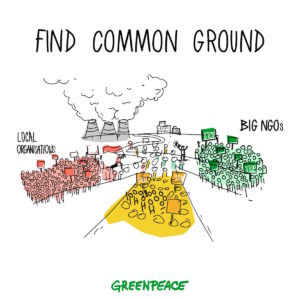I recently went along to an agency event in London about online communities, I admit I was attracted by the title “Digital Co-creation Lab”, wondering what it looks like from a commercial perspective. The picture that emerged is that business is still miles ahead of the NGO world when it comes to engaging our communities in co-creation and innovation.
Businesses across the spectrum are involving their customers, and competitors, in the development of products, marketing strategies and providing customer insights on their experiences (including reviewing T&Cs!) with greater depth and less cost than the traditional focus group.
Greenpeace agreed a global mobilisation strategy in May that says we will include supporter consultation in campaign planning and implementation for our key global campaigns. Seems long overdue. Supporters will be able to tell us when an idea is awesome and something they want to get involved with, or when we need to go back and try again. Or better still – as the examples from the Digital Co-creation Lab showed – give us their own ideas and insights to help drive the campaign.
Co-creation communities are different from crowdsourcing which is little more than outsourcing your work to a group of people. Co-creation is a collaborative process that taps into the creativity and knowledge of your various stakeholders, this could be to help with research, strategy, development, marketing, whatever. People share their ideas, and are also building, commenting and critiquing on other people’s ideas.
Unfortunately all the examples I have are commercial. Whatever you think of the products or services, the examples are helpful illustrations of how businesses are engaging customers in co-creating their work and brands. I’d love to hear about some NGO and charity examples, so if you have a story about an NGO insight community you’ve been involved in, please share.
7 models for co-creation communities, please steal and adapt
Insight communities, also known as MROCS in the biz (Market Research Online Communities), are often closed customer communities for research – to provide insight on products, services or marketing.
Example: Danone set up a community of 400 women called the Activia Advisory Board to help create new products and drive marketing campaigns. The Activia Single Pot was co-created by this community in five months – quicker than traditional methods. And Activia has found the insights from this community are also richer and more effective than focus groups.
Brand planning communities are typically closed and are a strategic tool to hardwire users into brand planning.
Example: Sony handpicked 1000 people from across the UK for their Sony Music Backstage community that they say helps shape their campaigns through brainstorms, debates, workshops and surveys and they update the community on the impact they are having on internal decision making.
Consumer “closeness” communities These are typically closed communities for quick tactical insight into their consumers. The aim is to get everyone in the organization to think more like their customers by understanding their lives and how they use their products.
Project based communities Not all online communities need to live forever, some of these co-creation communities are born around a specific problem or issue, once it is solved then the communities are shut down. These can be deployed to crack big challenges.
Example: Kraft wanted to reinvent the company mission. They created an online community that spanned 50 different markets and lasted four months to produce insights that defined a new corporate mission, vision and values. With the added bonus that everyone in the company was much more bought into the vision and committed to it in the company. They then shut down the community as planned.
Marketing communities Primary purpose is to drive sales. The aim is to turn people into advocates for their brand, and drive word of mouth. Usually open because they want lots of members and are often run through social media. I’m not sure this one is strictly co-creation.
Example: P&G’s beinggirl.com is worth noting because P&G rate it as four times as effective as their traditional marketing.
Customer service communities Does what it says on the tin. I could cynically say this is just free (for the company) customer service support, but there are some interesting examples.
Example: Mobile company Giffgiff says 50% of customer support queries are dealt by other customers. What makes this work is that the customers are incentivized with calling credit, cash via paypal or (I like this one) they can donate the credit they earn to charity.
Internal collaboration communities These leverage all of the creativity, skills, knowledge and insight from employees about the organisation and their products in a single place.
Example: My favourite recent example of this is WordPress.com. Their 120 staff all over the world use a WordPress blog theme called P2 to contribute ideas, build on ideas, get feedback, share mockups, and much more. Their co-founder Matt Mullenweg says 95% of their work happens on the blog. With 65 releases of code a day and almost no meetings this is a model for internal collaboration.
Now hit me with your inspiring non-profit community co-creation stories.



